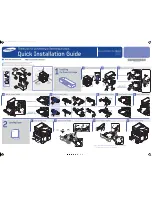
General information
1-13
5026
Paper guidelines
Paper characteristics
The following paper characteristics affect print quality and reliability. Consider these characteristics when
evaluating new paper stock.
Weight
—The printer can automatically feed paper weights from 60 to 162l7 g/m
2
(16 to 43 lb bond) grain long.
Paper lighter than 60 g/m
2
(16 lb) might not be stiff enough to feed properly, causing jams. For best
performance, use 75 g/m
2
(20 lb bond) grain long paper. For paper smaller than 182 x 257 mm (7.2 x 10.1 in.),
we recommend 90 g/m
2
(24 lb) or heavier paper.
Note:
Duplex is supported only for 63 g/m
2
–170 g/m
2
(17 lb–45 lb bond) paper.
Curl
—Curl is the tendency for paper to curl at its edges. Excessive curl can cause paper feeding problems. Curl
can occur after the paper passes through the printer, where it is exposed to high temperatures. Storing paper
unwrapped in hot, humid, cold, or dry conditions, even in the trays, can contribute to paper curling prior to
printing and can cause feeding problems.
Smoothness
—Paper smoothness directly affects print quality. If paper is too rough, toner cannot fuse to it
properly. If paper is too smooth, it can cause paper feeding or print quality issues. Always use paper between
100 and 300 Sheffield points; however, smoothness between 150 and 200 Sheffield points produces the best
print quality.
Moisture content
—The amount of moisture in paper affects both print quality and the ability of the printer to
feed the paper correctly. Leave paper in its original wrapper until it is time to use it. This limits the exposure of
paper to moisture changes that can degrade its performance.
Condition paper before printing by storing it in its original wrapper in the same environment as the printer for 24
to 48 hours before printing. Extend the time several days if the storage or transportation environment is very
different from the printer environment. Thick paper may also require a longer conditioning period.
Media weight, primary tray and option tray
Size
Type
Weight
Letter, Legal, A4
Xerographic and bond
Long grain
60 g/m
2
–162.7 g/m
2
(16 lb–43 lb)
Short grain
162.7 g/m
2
–198.9 g/m
2
(43 lb–53.2 lb)
Recycled
Long grain
75 g/m
2
–177 g/m
2
(20 lb–47 lb)
Short grain
105 g/m
2
–218 g/m
2
(28 lb–58 lb)
Cardstock (maximum)
Index long/short
162.7 g/m
2
–198.9 g/m
2
(90 lb–110 lb)
Cover long/short
162.7g/m
2
–198.9 g/m
2
(60.1 lb–73.6 lb)
Tag long/short
162.7g/m
2
–198.9 g/m
2
(100 lb–122.2 lb)
Transparencies
161 g/m
2
– 179 g/m
2
Thickness: 0.12–0.14mm (4.8–5.4 mil)
Labels
Paper
180 g/m
2
–300 g/m
2
(48 lb–80 lb)
Vinyl
180 g/m
2
–300 g/m
2
(48 lb–80 lb)
A5, JIS B5, Executive
Xerographic and bond
Long grain
75 g/m
2
–177 g/m
2
(20 lb to 47 lb)
Short grain
90 g/m
2
–218 g/m
2
(24 lb–58 lb)
Universal
Xerographic and bond
Long grain
75 g/m
2
–177 g/m
2
(20 lb–47 lb)
Short grain
90 g/m
2
–218 g/m
2
(24 lb–58 lb)
Summary of Contents for C734 series
Page 13: ...Notices and safety information xiii 5026 ...
Page 14: ...xiv Service Manual 5026 ...
Page 170: ...2 136 Service Manual 5026 ...
Page 288: ...4 72 Service Manual 5026 12 Remove the seven screws M securing the EP drive ...
Page 339: ...Repair information 4 123 5026 13 Remove the three printhead mounting screws D ...
Page 395: ...Connector locations 5 1 5026 5 Connector locations Locations ...
Page 408: ...7 2 Service Manual 5026 Assembly 1 Covers ...
Page 410: ...7 4 Service Manual 5026 Assembly 2 Front ...
Page 412: ...7 6 Service Manual 5026 Assembly 3 Right 1 2 3 4 5 6 ...
Page 414: ...7 8 Service Manual 5026 Assembly 4 Rear ...
Page 424: ...7 18 Service Manual 5026 Assembly 11 Options and features ...
Page 426: ...7 20 Service Manual 5026 ...
Page 436: ...I 10 Service Manual 5026 ...
















































